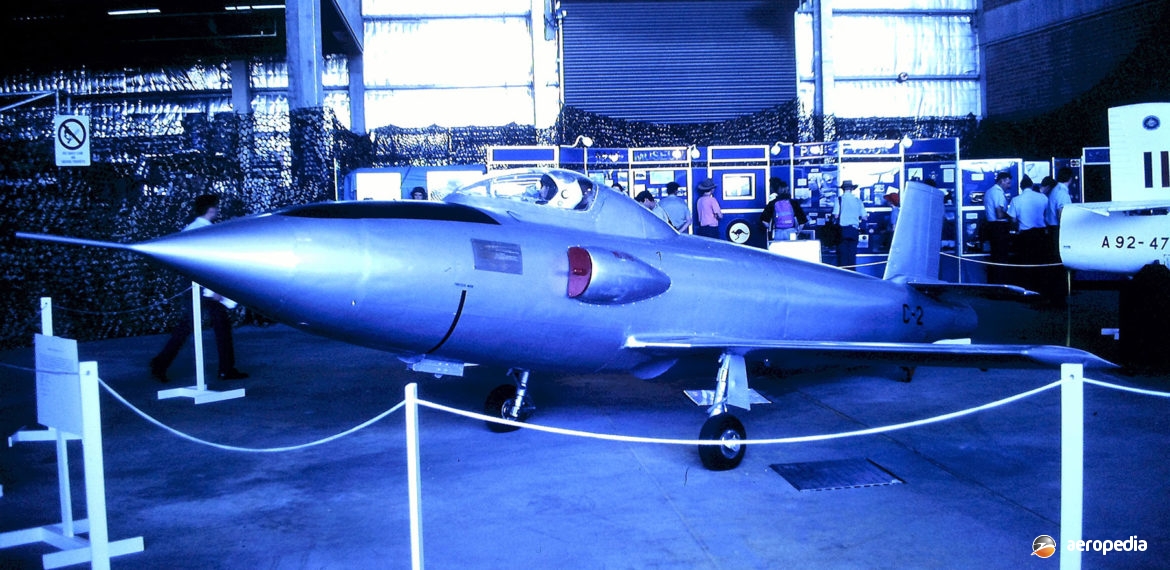Photograph:
GAF Pika C-2 at the RAAF Museum at Point Cook, VIC (David C Eyre)
Country of origin:
Australia
Description:
Single-seat research aircraft
Power Plant:
One 1,050 lbst Armstrong Siddeley Adder ASA.1 turbojet
Specifications:
- Wingspan: 5.8 m (19 ft)
- Length: 7.1 m (23 ft 3¾ in)
- Wing area: 7.06 m² (76 sq ft)
- Max speed at 8,230 m (27,000 ft): 756 km/h (470 mph)
- Initial rate of climb: 1,271 m/min (4,170 ft/min)
- Service ceiling: 9,754 m (32,000 ft)
- Empty weight: 1,043 kg (2,300 lb)
- Loaded weight: 1,315 kg (2,900 lb)
History:
In March 1948, following a series of meetings between members of the British Ministry of Supply and the Australian Department of Supply and Development, a specification was issued to cover the design and manufacture of a small high-speed pilotless aircraft for use in the guided weapon development program. This eventually culminated in the Jindivik.
Initially six pilotless and two piloted aircraft were to be built, to be fitted with the Armstrong Siddeley Adder ASA.1 gas turbine engine which provided 1,050 lbst. This engine was a pure-jet development of the Armstrong Siddeley Mamba propeller turbine which powered the Fairey Gannet carrier-borne anti-submarine aircraft.
Design work began at the Government Aircraft Factory (GAF) at Fishermen’s Bend, VIC, in the middle of 1948. The piloted machines became known as the Pika, an Aboriginal word meaning ‘flier’, and two were built. A mock-up of the aircraft was built and was placed on show at the Department of Supply stand at the Exhibition Building in Melbourne, VIC in about 1951.
The first prototype Pika after completion was assembled and had its engine run in October 1950 before being disassembled and conveyed by Bristol 170 Freighter on the 23rd to the Long Range Weapons Establishment (LRWE) at Woomera, SA where it was re-assembled and commenced taxiing trials.
Known as Project C, trials commenced on 29 October 1950 with GAF test pilot John Miles, and a brief lift-off was planned for 31 October but the aircraft could not get airborne. An attempt was made with flaps and it lifted off at 185 km/h (115 mph) and flew 1,067 m (3,500 ft). A second flight was made but on 15 November, when another flight was made, undercarriage problems caused a wheels-up landing. Damage was not serious and the aircraft was quickly rebuilt.
The prototype initially carried the serial C-1, and later A93-1. The second, C2 and later A93-2, followed some time later. Further flights were made without incident from 5 December 1950.
During early flights none of the autopilot or telemetry equipment was installed. The program called for evaluation of the systems in the second aircraft. Final testing was to involve remote flight by a ground controller, and also from a Gloster Meteor Mk 7. Between 31 October 1950 and 31 March 1951 John Miles completed 34 flights in Pika C-1 totalling 14 hours, the engine being changed after 31 flights.
Late in 1951 RAAF test pilot Flt Lt F O Knudson took over the test flying, this involving flight 36 to flight 44. On 5 April 1951 Pika C-1 flown by Knudson suffered a compressor stall and the pilot executed a dead engine crash landing on a nearby salt pan, the pilot being badly injured. The aircraft suffered extensive damage and was written off.
Subsequently work proceeded apace to complete the second aircraft, Pika C-2, and, after completion and ground tests at GAF, the aircraft was transported on 26 April 1951 to Woomera where testing continued. Trials with the Pika concluded in June 1954, by which time 214 flights had been completed, 44 in C-1 and 170 in C-2.
These two aircraft accumulated 100 hours of flying time in checking the general characteristics of the design, proving the various components of the remote controlling system, and developing new equipment. Design work continued to the Jindivik, of which 502 were completed.
The Pika differed little from the pilotless aircraft either in overall dimensions or in basic layout or plan form. Its total weight was not very much greater since, by reducing its fuel capacity and omitting some special items of equipment required only on target trials, the additional weight associated with the pilot was almost counterbalanced.
However, there were three major differences between the Jindivik and the Pika. The latter had a complete cockpit with all the necessary flying and engine instruments, controls, oxygen system, etc. Secondly, the air for the engine was acquired through intakes on either side of the fuselage adjacent to the cockpit, instead of the dorsal entry on the Jindivik. In addition, the pilotless version landed on a skid, whereas the Pika required more ground mobility and was fitted with a retractable undercarriage. The main legs contained conventional oleo-pneumatic struts and 33 cm (13 in) diameter wheels, hydraulic brakes, and a tail-skid with an oleo-pneumatic strut, which was not retractable.
The two Pikas differed only slightly: A93-2 had a probe in the nose, whereas A93-1 had a rounded nose. One Pika has been preserved, A93-2, being part of the collection of the RAAF Museum at Point Cook, VIC.

